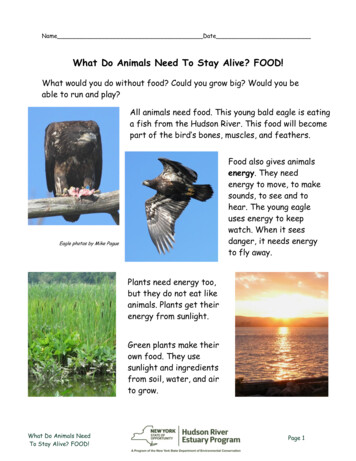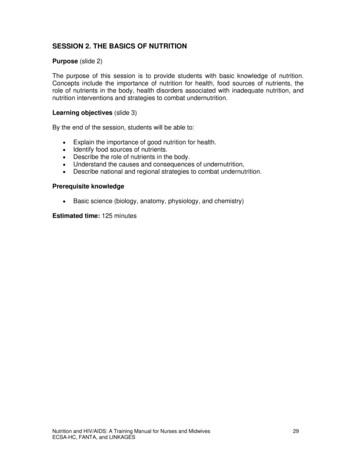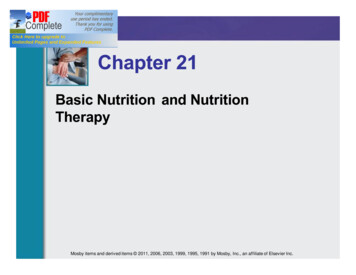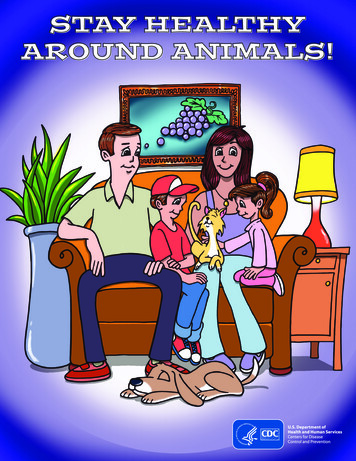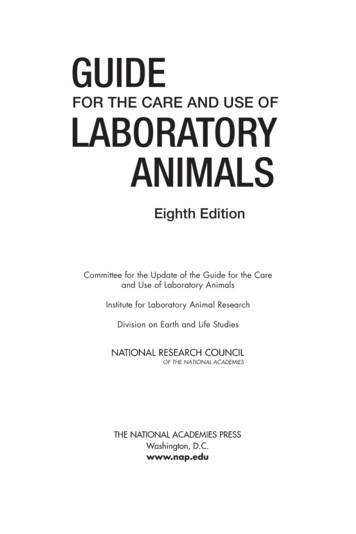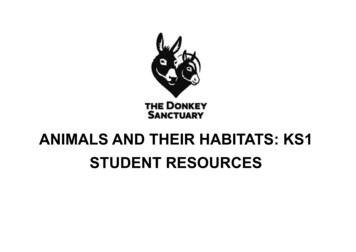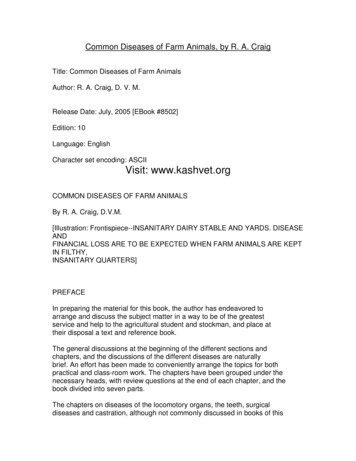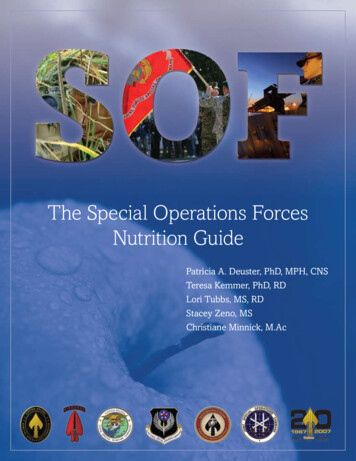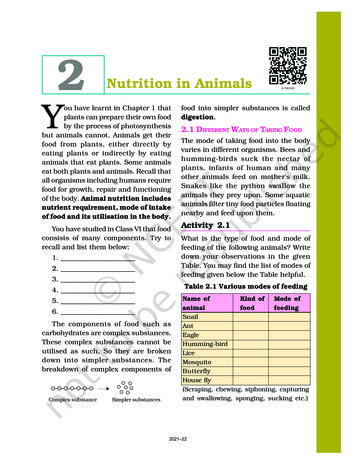
Transcription
2Nutrition in AnimalsYou have learnt in Chapter 1 thatplants can prepare their own foodby the process of photosynthesisbut animals cannot. Animals get theirfood from plants, either directly byeating plants or indirectly by eatinganimals that eat plants. Some animalseat both plants and animals. Recall thatall organisms including humans requirefood for growth, repair and functioningof the body. Animal nutrition includesnutrient requirement, mode of intakeof food and its utilisation in the body.You have studied in Class VI that foodconsists of many components. Try torecall and list them below:1.2.3.5.6.The components of food such ascarbohydrates are complex substances.These complex substances cannot beutilised as such. So they are brokendown into simpler substances. Thebreakdown of complex components ofSimpler substances2.1 DIFFERENT WAYS OF TAKING FOODThe mode of taking food into the bodyvaries in different organisms. Bees andhumming-birds suck the nectar ofplants, infants of human and manyother animals feed on mother’s milk.Snakes like the python swallow theanimals they prey upon. Some aquaticanimals filter tiny food particles floatingnearby and feed upon them.Activity 2.1What is the type of food and mode offeeding of the following animals? Writedown your observations in the givenTable. You may find the list of modes offeeding given below the Table helpful.Table 2.1 Various modes of feeding4.Complex substancefood into simpler substances is calleddigestion.Name ofKind ofMode squitoButterflyHouse fly(Scraping, chewing, siphoning, capturingand swallowing, sponging, sucking etc.)2021–22
Amazing factStarfish feeds on animals covered byhard shells of calcium carbonate.After opening the shell, the starfishpops out its stomach through itsmouth to eat the soft animal insidethe shell. The stomach then goes backinto the body and the food is slowlydigested.of the stomach and the small intestine,and the various glands associated with thecanal such as salivary glands, the liverand the pancreas secrete digestive juices.The digestive juices convert complexBuccal cavitySalivary glandOesophagusLiverFig. 2.1 Starfish2.2 DIGESTIONINGall bladderHUMANSStomachPancreasWe take in food through the mouth,digest and utilise it. The unused partsof the food are defecated. Have you everwondered what happens to the foodinside the body? The food passesthrough a continuous canal (Fig. 2.2)which begins at the buccal cavity andends at the anus. The canal can bedivided into various compartments:(1) the buccal cavity, (2) foodpipe oroesophagus, (3) stomach, (4) smallintestine, (5) large intestine ending inthe rectum and (6) the anus. Is it not avery long path? These parts togetherform the alimentary canal (digestivetract). The food components graduallyget digested as food travels through thevarious compartments. The inner wallsSmallintestineLargeintestineRectumAnusFig. 2.2 Human digestive systemsubstances of food into simpler ones. Thedigestive tract and the associated glandstogether constitute the digestive system.Now, let us know what happens tothe food in different parts of the digestivetract.The mouth and buccal cavityFood is taken into the body through themouth. The process of taking food into12SCIENCE2021–22
Milk teeth and permanent teethDo you remember about falling of your teeth some years ago? The first set ofteeth grows during infancy and they fall off at the age between six to eightyears. These are termed milk teeth. The second set that replaces them are thepermanent teeth. The permanent teeth may last throughout life or fall offduring old age or due to some dental disease.MolarBoojho is fascinated by thehighly coiled small intestine seenin Fig. 2.2. He wants to know itslength. Would you like to make awild guess? We have given itsapproximate length on page 16.Just imagine how such a longstructure is accommodated in asmall space within our body!PremolarCanineIncisorthe body is called ingestion. We chewthe food with the teeth and break itdown mechanically into small pieces.Each tooth is rooted in a separate socketin the gums (Fig. 2.3). Our teeth vary inappearance and perform differentfunctions. Accordingly they are givendifferent names (Fig. 2.3).Fig. 2.3 Arrangement of teeth and differenttype of teethwhich ones for piercing and tearing?Also find out the ones that are used forchewing and grinding?Record your observations in Table 2.2Activity 2.2Type of teethWash your hands. Look into themirror and count your teeth. Useyour index finger to feel the teeth.How many kinds of teeth could youfind? Take a piece of an apple orbread and eat it. Which teeth doyou use for biting and cutting, andCutting andbiting teethPiercing andtearing teethChewing andgrinding teethNUTRITION IN ANIMALSTable 2.2Number of teethTotalLower jaw Upper jaw132021–22
Our mouth has the salivary glandswhich secrete saliva. Do you know theaction of saliva on food? Let us find out.Activity 2.3Take two test tubes. Label them ‘A’ and‘B’. In test tube ‘A’ put one teaspoonfulIodine solutionWaterBoiled riceABoiled and chewed riceBFig. 2.4 Effect of saliva on starchof boiled rice; in test tube ‘B’ keep oneteaspoonful of boiled rice after chewingit for 3 to 5 minutes. Add 3–4 mL ofwater in both the test tubes (Fig. 2.4).Now pour 2–3 drops of iodine solutionin each test tube and observe. Why isthere a change in colour in the testtubes? Discuss the results with yourclassmates and your teacher. The salivabreaks down the starch into sugars.The tongue is a fleshy muscularorgan attached at the back to the floorof the buccal cavity. It is free at the frontand can be moved in all directions. Doyou know the functions of the tongue?We use our tongue for talking. Besides,it mixes saliva with the food duringchewing and helps in swallowing food.We also taste food with our tongue. Ithas taste buds that detect differenttastes of food. We can find out theSweets and tooth decayNormally bacteria are present in our mouth but they are not harmfulto us. However, if we do not clean our teeth and mouth after eating,many harmful bacteria also begin to live and grow in it. These bacteriabreak down the sugars present from the leftover food and releaseacids (see Chapter 5 to know what an acid is). The acids graduallydamage the teeth (Fig. 2.5). This is called tooth decay. If it is nottreated in time, it causes severe toothache and in extreme casesresults in tooth loss. Chocolates, sweets, soft drinks and other sugarproducts are the major culprits of tooth decay.Therefore, one should clean the teeth with a brush or datun anddental floss (a special strong thread which is moved between twoteeth to take out trapped food particles) at least twice a day andrinse the mouth after every meal. Also, one should not put dirtyfingers or any unwashed object in the mouth.(a)(b)(c)(d)Fig. 2.5 Gradual decay of tooth14SCIENCE2021–22
Sometimes when you eat in a hurry, talk or laugh while eating, you may cough,get hiccups or a choking sensation. This happens when food particles enter thewindpipe. The windpipe carries air from the nostrils to the lungs. It runs adjacentto the foodpipe. But inside the throat, air and food share a common passage.Then how is food prevented from entering the windpipe? During the act ofswallowing a flap-like valve closes the passage of the windpipe and guides thefood into the foodpipe. If, by chance, food particles enter the windpipe, we feelchoked, get hiccups or cough.5. Now write down your observationsand label Fig. 2.6.Repeat this activity with otherclassmates.The foodpipe/oesophagusFig. 2.6 Regions of thetongue for different tastesThe swallowed food passes into thefoodpipe or oesophagus. Look at Fig. 2.2.The foodpipe runs along the neckposition of taste buds by the followingactivity.Paheli wants to know howfood moves in the oppositedirection during vomiting.Activity 2.41. Prepare a separate sample each of(i) sugar solution, (ii) common saltsolution, (iii) lemon juice and (iv) juiceof crushed neem leaf or bitter gourd.2. Blindfold one of your classmates andask her/him to take out the tongueand keep it in straight and flat position.3. Use a clean toothpick to put theabove samples one by one ondifferent areas of the tongue asshown in Fig. 2.6. Use a newtoothpick for each sample.4. Ask the classmate which areas of thetongue could detect the sweet, salty,sour and bitter substances.FoodOesophagusStomachFig. 2.7 Movement of thefood in the oesophagusof the alimentary canalNUTRITION IN ANIMALS152021–22
and the chest. Food is pushed down bymovement of the wall of the foodpipe.Actually this movement takes placethroughout the alimentary canal andpushes the food downwards (Fig. 2.7).At times the food is not accepted by ourstomach and is vomited out. Recall theinstances when you vomited after eatingand think of the reason for it. Discusswith your parents and teacher.The stomachThe stomach is a thick-walled bag. Itsshape is like a flattened J and it is thewidest part of the alimentary canal. Itreceives food from the food pipe at oneend and opens into the small intestineat the other.The inner lining of the stomachsecretes mucous, hydrochloric acid anddigestive juices. The mucous protectsthe lining of the stomach. The acid killsmany bacteria that enter along with thefood and makes the medium in thestomach acidic and helps the digestivejuices to act. The digestive juices breakdown the proteins into simplersubstances.The small intestineThe small intestine is highly coiled andis about 7.5 metres long. It receivessecretions from the liver and the pancreas.Besides, its wall also secretes juices.The liver is a reddish brown glandsituated in the upper part of theabdomen on the right side. It is thelargest gland in the body. It secretes bilejuice that is stored in a sac called thegall bladder (Fig. 2.2). The bile playsan important role in the digestion of fats.The pancreas is a large creamcoloured gland located just below thestomach (Fig. 2.2). The pancreatic juiceacts on carbohydrates, fats and proteinsand changes them into simpler forms.The working of the stomach was discovered by astrange accident. In 1822, a man named Alexis St.Martin was badly hit by a shot gun. The bullet hadseriously damaged the chest wall and made a holein his stomach. He was brought to an Americanarmy doctor William Beaumont. The doctor savedthe patient but he could not close the hole properlyand left it bandaged (Fig. 2.8). Beaumont took it asa great opportunity to see the inside of the stomachthrough the hole. He made some wonderfulobservations.Beaumont found that the stomach was churning Fig. 2.8 Alexis St. Martin’sshotgun woundfood. Its wall secreted a fluid which could digestthe food. He also observed that the end of the stomach opens into the intestineonly after the digestion of the food inside the stomach is completed.16SCIENCE2021–22
The partly digested food now reaches thelower part of the small intestine wherethe intestinal juice completes thedigestion of all components of the food.The carbohydrates get broken intosimple sugars such as glucose, fats intofatty acids and glycerol, and proteinsinto amino acids.proteins required by the body. This iscalled assimilation. In the cells, glucosebreaks down with the help of oxygeninto carbon dioxide and water, andenergy is released. The food thatremains undigested and unabsorbedenters into the large intestine.Absorption in the smallintestineThe large intestine is wider and shorterthan small intestine. It is about 1.5 metrein length. Its function is to absorb waterand some salts from the undigested foodmaterial. The remaining waste passesinto the rectum and remains there assemi-solid faeces. The faecal matter isremoved through the anus fromtime-to-time. This is called egestion.The digested food can now pass into theblood vessels in the wall of the intestine.This process is called absorption. Theinner walls of the small intestine havethousands of finger-like outgrowths.These are called villi (singular villus).Can you guess what the role of villi couldbe in the intestine? The villi increasethe surface area for absorption of thedigested food. Each villus has a networkof thin and small blood vessels close toits surface. The surface of the villiabsorbs the digested food materials. Theabsorbed substances are transportedvia the blood vessels to different organsof the body where they are used to buildcomplex substances such as theLarge intestine2.3 DIGESTION IN GRASS-EATINGANIMALSHave you observed cows, buffaloesand other grass-eating animalschewing continuously even whenthey are not eating? Actually, theyquickly swallow the grass and storeit in a part of the stomach calledrumen (Fig. 2.9). Here the food getsDiarrhoeaSometime you may have experienced the need to pass watery stool frequently.This condition is known as diarrhoea. It may be caused by an infection, foodpoisoning or indigestion. It is very common in India, particularly among children.Under severe conditions it can be fatal. This is because of the excessive loss ofwater and salts from the body. Diarrhoea should not be neglected. Even before adoctor is consulted the patient should be given plenty of boiled and cooled waterwith a pinch of salt and sugar dissolved in it. This is called Oral RehydrationSolution (ORS).NUTRITION IN ANIMALS172021–22
Paheli wants to know whythese animals cannot chewfood properly at the time theytake it in?Boojho wants to know whywe cannot digest celluloselike the cattle do.partially digested and is called cud.But later the cud returns to the mouthin small lumps and the animal chewsit. This process is called rumination andthese animals are called ruminants.The grass is rich in cellulose, a typeof carbohydrate. In ruminants like cattle,deer, etc., bacteria present in rumenOesophagusSmall IntestineRumenhelps in digestion of cellulose. Manyanimals, including humans, cannotdigest cellulose.Animals like horses, rabbit, etc., havea large sac-like structure called Caecumbetween the oesophagus and the smallintestine (Fig. 2.9). The cellulose of thefood is digested here by the action ofcertain bacteria which are not present inhumans.So far you have learnt about animalswhich possess the digestive system. Butthere are many small organisms which donot have a mouth and a digestive system.Then, how do they acquire and digestfood? In the section below you will learnanother interesting way of food intake.2.4 FEEDING AND DIGESTIONAMOEBAINAmoeba is a microscopic single-celledorganism found in pond water. Amoebahas a cell membrane, a rounded, densenucleus and many small bubble-likevacuoles (Fig. 2.10) in its cytoplasm.Amoeba constantly changes its shapeand position. It pushes out one, ormore finger-like projections, calledpseudopodia or false feet for movementand capture of food.NucleusPseudopodiumFood particle(ingestion)Food vacuoleStomachLarge IntestineCaecumEgested wasteFig. 2.10 AmoebaFig. 2.9 Digestive system of ruminant18SCIENCE2021–22
Amoeba feeds on some microscopicorganisms. When it senses food, itpushes out pseudopodia around thefood particle and engulfs it. The foodbecomes trapped in a food vacuole[Fig. 2.10).Digestive juices are secreted into thefood vacuole. They act on the food andbreak it down into simpler substances.Gradually the digested food is absorbed.The absorbed substances are used forgrowth, maintenance and multiplication.The undigested residue of the food isexpelled outside by the vacuole.The basic process of digestion offood and release of energy is the samein all animals. In a later chapter youwill learn about the transport of foodabsorbed by the intestine to the variousparts of the body.KeywordsAbsorptionAmino acidAmoebaAssimilationBileBuccal cavityCanineCelluloseDigestionEgestionFatty acidFood vacuoleGall bladderGlycerolIncisorIngestionLiverMilk teethMolarPermanent inantRuminationSalivary glandsVilliSalivaWhat you have learntnAnimal nutrition includes nutrient requirement, mode of intake of foodand its utilisation in the body.nThe human digestive system consists of the alimentary canal andsecretory glands. It consists of the (i) buccal cavity, (ii) oesophagus,(iii) stomach, (iv) small intestine, (v) large intestine ending in rectumand (vi) anus. The main digestive glands which secrete digestive juicesare (i) the salivary glands, (ii) the liver and (iii) the pancreas. The stomachwall and the wall of the small intestine also secrete digestive juices.nThe modes of feeding vary in different organisms.nNutrition is a complex process involving: (i) ingestion, (ii) digestion,(iii) absorption, (iv) assimilation and (v) egestion.NUTRITION IN ANIMALS192021–22
nDigestion of carbohydrates, like starch, begins in the buccal cavity. Thedigestion of protein starts in the stomach. The bile secreted from theliver, the pancreatic juice from the pancreas and the digestive juicefrom the intestinal wall complete the digestion of all components of foodin the small intestine. The digested food is absorbed in the blood vesselsfrom the small intestine.nThe absorbed substances are transported to different parts of the body.Water and some salts are absorbed from the undigested food in thelarge intestine.nThe undigested and unabsorbed residues are expelled out of the bodyas faeces through the anus.nThe grazing animals like cows, buffaloes and deer are known asruminants. They quickly ingest, swallow their leafy food and store it inthe rumen. Later, the food returns to the mouth and the animal chews itpeacefully.nAmoeba ingests its food with the help of its false feet or pseudopodia.The food is digested in the food vacuole.Exercises1. Fill in the blanks:(a) The main steps of nutrition in humans are , ,, and .(b) The largest gland in the human body is .(c) The stomach releases hydrochloric acid and juices whichact on food.(d) The inner wall of the small intestine has many finger-like outgrowthscalled .(e) Amoeba digests its food in the .2. Mark ‘T’ if the statement is true and ‘F’ if it is false:(a) Digestion of starch starts in the stomach. (T/F)(b) The tongue helps in mixing food with saliva. (T/F)(c) The gall bladder temporarily stores bile. (T/F)(d) The ruminants bring back swallowed grass into their mouthand chew it for some time. (T/F)3. Tick (ü) mark the correct answer in each of the following:(a) Fat is completely digested in the(i) stomach (ii) mouth (iii) small intestine (iv) large intestine20SCIENCE2021–22
(b) Water from the undigested food is absorbed mainly in the(i) stomach (ii) foodpipe (iii) small intestine (iv) large intestine4. Match the items of Column I with those given in Column II:Column IColumn IIFood componentsProduct(s) of digestionCarbohydratesFatty acids and glycerolProteinsSugarFatsAmino acids5. What are villi? What is their location and function?6. Where is the bile produced? Which component of the food does it help todigest?7. Name the type of carbohydrate that can be digested by ruminants butnot by humans. Give the reason also.8. Why do we get instant energy from glucose?9. Which part of the digestive canal is involved in:(i)absorption of food .(ii)chewing of food .(iii)killing of bacteria .(iv)complete digestion of food .(v)formation of faeces .10. Write one similarity and one difference between the nutrition in amoebaand human beings.11. Match the items of Column I with suitable items in Column IIColumn I(a) Salivary glandColumn II(i)Bile juice secretion(b) Stomach(ii)Storage of undigested food(c)(iii)Saliva secretion(d) Rectum(iv)Acid release(e)Small intestine(v)Digestion is completed(f )Large intestine(vi)Absorption of waterLiver(vii)Release of faecesNUTRITION IN ANIMALS212021–22
12. Label Fig. 2.11 of the digestive system.Fig. 2.11 A part of human digestive system13. Can we survive only on raw, leafy vegetables/grass? Discuss.Extended Learning — Activities and Project1. Visit a doctor and find out:(i)Under what conditions does a patient need to be on a drip ofglucose?(ii)Till when does a patient need to be given glucose?(iii)How does glucose help the patient recover?Write the answers in your notebook.2. Find out what vitamins are and get the following information.(i)Why are vitamins necessary in the diet?(ii)Which fruits or vegetables should be eaten regularly to getvitamins?Write a one-page note on the information collected by you. You may takehelp of a doctor, a dietician, your teacher or any other person, or fromany other source.22SCIENCE2021–22
3.Collect data from your friends, neighbours and classmates to know moreabout “milk teeth”.Tabulate your data. One way of doing it is given below:S. No. Age at whichfirst tooth fellAge at whichlast tooth fellNo. of teethlostNo. of teethreplaced1.2.3.4.5.Find out from at least twenty children and find the average age at whichchildren lose the milk teeth. You may take help of your friends.Did you know?Fats in goat’s milk are much simpler than those in cow’s milk. Therefore,the goat’s milk is much easier to digest than the cow’s milk.NUTRITION IN ANIMALS232021–22
down into simpler substances. The breakdown of complex components of Table 2.1 Various modes of feeding Name of Kind of Mode of animal food feeding Snail Ant Eagle Humming-bird Lice Mosquito Butterfly House fly (Scraping, chewing, siphoning, capturing and swallowing, sponging, sucking etc.) food

